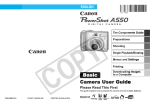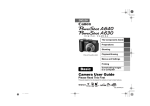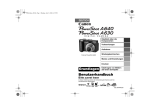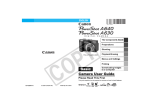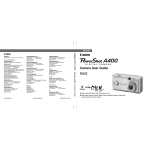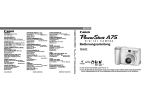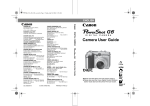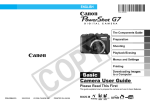Download Canon power shot S51S User guide
Transcript
ENGLISH The Components Guide Preparations Pending Shooting Playback/Erasing Menus and Settings Printing Downloading Images to a Computer Basic Camera User Guide Please Read This First This guide explains how to prepare the camera and use its basic features. CDI-E274-010 xxxxxxx © 2007 CANON INC. PRINTED IN JAPAN Flowchart and Reference Guides The following guides are available. Refer to them as necessary according to the flowchart below. For information on included items and items sold separately System Map The Components Guide Preparations • Installing the batteries and memory card • Opening the LCD monitor • Setting the date, time and language Shooting Playback/Erasing Basic Camera User Guide (This Guide) • Read this first. Menus and Settings Handling precautions, references to the various shooting and playback functions Printing • Installing the software • Downloading images to a computer • Using the software Advanced Camera User Guide Direct Print User Guide Basic Camera User Guide (This Guide) Software Starter Guide You may not be able to achieve the full performance of this camera with the included memory card. ZoomBrowser EX/ ImageBrowser Software User Guide • PDF manuals available on the Canon website. http://web.canon.jp/ Imaging/information-e.html In this guide, the Basic Camera User Guide is called the Basic Guide, and the Advanced Camera User Guide is called the Advanced Guide. The Components Guide Front View The Components Guide a Zoom Lever (p. 14, Advanced Guide pp. 104, 105) Shooting: (Telephoto) / (Wide Angle) Playback: (Magnify) / (Index) b Shutter Button (p. 9) c (Continuous) / (Self-Timer) Button (Advanced Guide p. 46, Basic Guide p. 18) d Neck Strap Mount e Power/Mode Indicator (p. 4) f Self-Timer Lamp/Red-Eye Reduction Lamp/Tally Lamp (p. 18, Advanced Guide pp. 42, 51) g Flash (p. 14) h Microphone (Advanced Guide pp. 119, 121) i AF-assist Beam (Advanced Guide pp. 29, 148) j Speaker k MF (Manual Focus) Button (Advanced Guide p. 75) l (Macro) Button (p. 16) m Lens n Ring Release Button (Advanced Guide p. 169) 1 Back View a LCD Monitor (Advanced Guide p. 13) b Viewfinder (Advanced Guide p. 13) c DC IN (Power input) Terminal (Advanced Guide p. 166) d Terminal Cover e A/V OUT (Audio/Video output) Terminal (Advanced Guide p. 130) f DIGITAL Terminal (p. 28) g Memory Card Slot/Battery Cover (p. 5) h Memory Card Slot/Battery Cover Lock (p. 5) i Tripod Socket Attaching the Neck Strap Attach the strap as illustrated. Check that the strap does not come loose from the strap mount when pulled. Perform the same steps on the other side of the camera. In order to avoid dropping the camera, we recommend attaching the neck strap before using the camera. 2 Controls The Components Guide (Print/Share) / (Shortcut) (p. 23, Advanced Guide p. 98) (Flash) / (Microphone) Button (p. 14, Advanced Guide pp. 119, 121) c Diopter Adjustment Dial (Advanced Guide p. 14) d Hot Shoe (Advanced Guide p. 172) e Movie Button (p. 10, Advanced Guide p. 50) f Mode Dial (pp. 9, 11) g OFF Button h Mode Lever (p. 7) i Omni Selector S (Up) / (Exposure) Button (Advanced Guide p. 83) T (Down) Button W (Left) Button X (Right) Button j SET/ (AF Frame Selector) Button (p. 21, Advanced Guide pp. 26, 69) k MENU Button (p. 22, Advanced Guide p. 27) l Indicator (p. 4) m DISP. (Display) Button (Advanced Guide p. 13) n ISO/ (Jump) Button (Advanced Guide pp. 80, 107) o FUNC. (Function) / (Single Image Erase) Button (p. 21, Advanced Guide p. 26) a b 3 Attaching/Removing the Lens Cap Squeeze both sides of the lens cap (a), and remove (b). Always replace the lens cap after use. • Attach the lens cap cord to the strap. • Remove the lens cap before turning on the camera’s power. Indicators The camera indicators will light or blink under the following conditions. Never do the following while the indicator blinks red. These actions may corrupt image data. - Shake or jolt the camera - Shut off the power, or open the memory card slot/battery cover z Power/Mode Indicator Orange: Shooting mode Green: Playback mode/Printer connection Yellow: Computer connection z Indicator Blinking Red: Image recording/reading/erasing/transferring (when connected to a computer) 4 Preparations 1. Installing the batteries. 1. Slide the memory card slot/battery cover lock (a) and open the cover (b). 2. Insert the 4 supplied AA-size alkaline batteries, or separately sold AA-size NiMH batteries. Memory card slot/battery cover lock Preparations Î See the Advanced Guide: Battery Handling (p. 159). 2. Inserting the memory card. 1. Insert the memory card until it clicks into place. 2. Close the memory card slot/battery cover (a), pressing down and sliding it until it clicks into place (b). Front Ensure that the memory card is correctly oriented before inserting it in the camera. It may damage the camera, or the camera may not recognize the card, if it is inserted incorrectly. Î See the Advanced Guide: Handling the Memory Card (p. 161). Î See the Advanced Guide: Formatting Memory Cards (p. 37). 5 To Remove the Memory Card Push the memory card with your finger until the memory card clicks and then release it. You can use SD memory cards, SDHC memory cards and MultiMediaCards with this camera. These cards are collectively called memory cards in this guide. Opening the LCD Monitor You can position the LCD monitor in the following ways. 1. Move it right or left 180 degrees. 2. Tilt it forward 180 degrees toward the lens or backward 90 degrees. When the LCD monitor is tilted 180 degrees toward the lens, the displayed image is automatically flipped and reversed (the Reverse Display function). * 6 The Reverse Display function can be set to off. Î See the Advanced Guide: Rec. Menu (p. 29). 3. Fold the LCD monitor back against the camera body until it clicks into place. When the LCD monitor clicks into place, the image will display normally (not reversed). See the Advanced Guide: Using the LCD Monitor and the Î Viewfinder (p. 13). Always keep the LCD monitor closed with the display facing the camera body when the camera is not in use. When you push the LCD monitor until you hear the clicking sound, the LCD monitor will automatically turn off, and the image will display in the viewfinder. Turning the Power On/Off Power/Mode Indicator Mode Lever Release button Preparations 1. Turn the mode lever to (Shooting) or (Playback) while pressing the release button. The power/mode indicator lights orange or green. • When switching between shooting and playback, turn the mode lever to or * while pressing the release button. * The camera switches to Playback mode, but the lens does not retract (the lens will retract if you turn the mode lever to once more). • In Playback mode, you can also switch to Shooting mode by pressing the shutter button halfway or pressing the Movie button. 2. Press the OFF button to turn the power off. 7 First Time Settings Setting the Date/Time 1. Turn the camera on (a) in Shooting mode ( ) or Playback mode ( ). 2. Select the item you wish to set using the W or X button and set its value using the S or T button (b). To set daylight saving time, select and set it with the S or T button. 3. Confirm that the correct time is displayed and press the SET button (c). The date/time can also be set in the Set up menu (p. 22). When you turn on the camera the first time, or when the lithium date battery charge is low, the [Date/Time] menu appears. Î See the Advanced Guide: Replacing the Date Battery (p. 177). Setting the Display Language 1. Turn the camera on (a) in Playback mode ( ). 2. Hold down the SET button and press the MENU button. 3. Use the S, T, W or X button to select a language, then press the SET button. The display language can also be set in the Set up menu (p. 22). 8 Shooting Shooting (Still Images) 1. Turn the camera on in Shooting mode ( ) (p. 7). The start-up sound will play and the start-up image will display on the LCD monitor. However, when starting with the viewfinder display, the start-up image is not displayed and there is no start-up sound. • When you hold down the button while turning on the camera, the mute setting is [On]. All sounds except for warning sounds will be disabled. Î See the Advanced Guide: Using the LCD Monitor and the Viewfinder (p. 13). Î See the Advanced Guide: Power Saving Function (p. 22). Î See the Advanced Guide: Set up Menu (p. 32). Shooting 2. Set the mode dial to . 3. Aim the camera at the subject. 4. Focus and shoot. 1. Press the shutter button lightly (halfway) to focus. Two beeps will sound when the camera has finished focusing, and the AF frame appears green in the LCD monitor (or viewfinder). • If the message “Raise the flash” appears, we recommend shooting with a flash (p. 14). • The Image Stabilizer function is set to [On] by default. • The beep will sound one time if the subject is difficult to focus on. Î See the Advanced Guide: Setting the Image Stabilizer Function (p. 44). Î See the Advanced Guide: Shooting Hard-to-Focus Subjects (Focus Lock, AF Lock, Manual Focus) (p. 73). 9 2. Press the shutter button fully (all the way) to shoot. The shutter sound will play, and the image will record. The indicator will blink red while the image is recorded to the memory card. Î See Selecting a Shooting Mode (p. 11). Î See Indicators (p. 4). Î See the Advanced Guide to verify the advanced shooting method. Reviewing an Image Right After Shooting After a shot is taken, the image appears in the LCD monitor for approximately 2 seconds. You can continue to display images regardless of the review duration setting with the following procedures. • Keeping the shutter button pressed after a shot. • Pressing the SET or DISP. button while the image is displayed in the LCD monitor. To stop displaying the image, press the shutter button halfway. Î See the Advanced Guide: Review (p. 29). Î See Erasing (p. 20). Shooting (Movies) No matter what position the mode dial is in, you can shoot movies with just a push of the movie button. Movie button • Max. Clip Size: 4 GB*. • Sound is recorded in stereo. • Pressing the Movie button again stops recording. * Even before the recording size reaches 4 GB, recording will stop at the moment the recording time reaches 1 hour. Depending on memory card capacity and data write speed, recording may stop before the file size reaches 4 GB or the recording time reaches 1 hour. 10 Selecting a Shooting Mode 1. Set the mode dial to the desired mode (a). In the modes, use the W or X button to select a shooting mode (b). Creative Zone Auto Image Zone Shooting Modes The camera automatically selects settings. When a shooting mode appropriate for the shooting conditions is selected, the camera automatically adjusts settings for optimal shooting. Portrait Produces a soft effect when photographing people. Landscape Optimized for shooting landscape scenes which contain both near and far subjects. Night Snapshot Allows you to take snapshots of people against twilight or night backgrounds by reducing the effects of camera shake even without using a tripod. Sports Shoots continuous images with autofocus. Well suited for shooting moving subjects (You can change continuous shooting settings. (See the Advanced Guide p. 46)). Image Zone Shooting Auto 11 (Special Scene) You can shoot with the most appropriate settings for the scene. Night Scene Allows you to capture human subjects against the backdrop of an evening sky or night scene. The flash is directed at the person and the shutter speed is slow, so both the person and the background can be beautifully shot. Image Zone 12 Indoor Prevents camera shake and maintains the subject’s true color when shooting under fluorescent or tungsten lighting. Foliage Shoots trees and leaves such as new growth, autumn leaves or blossoms - in vivid colors. Snow Shoots without a blue tinge and without making people appear dark against a snowy background. Beach Shoots without making people appear dark near water or sand where reflected sunlight is strong. Fireworks Captures fireworks in the sky sharply and at optimal exposure. Aquarium Selects the optimal ISO speed, white balance and color balance to capture fish and other items in an indoor aquarium. Color Accent Use this option to have only the color specified in the LCD monitor remain and to transform all others to black and white. Î See the Advanced Guide (p. 59). Color Swap Use this option to transform a color specified in the LCD monitor into another. Î See the Advanced Guide (p. 60). Stitch Assist Allows you to shoot overlapping images that can later be merged (stitched) to create one panoramic image on a computer. Î See the Advanced Guide (p. 57). Image Zone Movie No matter what position the mode dial is in, you can select from 4 different recording pixels/frame rate settings and shoot movies. When the mode dial is set to , you can set AE lock and exposure shift before shooting. The following movie modes are available: Color Accent (for shooting in black and white except for specified colors), Color Swap (for changing a specified color into another) of mode and My Colors of FUNC. menu. Î See the Advanced Guide (p. 50). Î See the Advanced Guide (pp. 63 - 68). Shooting , , , Creative You can freely select camera settings such as the exposure and Zone aperture value to suit your shooting purposes. • Results may vary depending on the subject. • The shutter speed is slow in or mode. Always use a tripod to avoid camera shake. • In , , , , , or mode, the ISO speed may increase and cause noise in the image depending on the scene being shot. • In mode, shoot with the subject more than 1 m (3.3 ft.) – infinity (zoom range: maximum wide angle) or 4 m (13.1 ft.) – infinity (zoom range: maximum telephoto angle) away from the front of the lens. • In mode, the camera shake warning icon may appear on the LCD monitor (or viewfinder) since slower shutter speeds are frequently used in this mode. If this happens, affix the camera to a tripod. 13 Using the Zoom 1. Press the zoom lever toward or . The zoom can be adjusted from 36 – 432 mm (focal length) in 35mm film equivalent terms. While adjusting the zoom, a distance representing the focus range (rough guide) for AF (auto focus) appears below the zoom bar. • Zooming speed can be controlled with the zoom lever. Pressing the zoom lever fully left or right zooms quickly, while pressing lightly zooms slowly. Zoom Bar Focus range (rough guide) Wide Angle: Zooms out from the subject (the subjects will be small). Telephoto: Zooms in on the subject. Using the Flash 1. Raise the flash manually. 2. Press the button (a) and use the W or X button to select the flash settings (b). b 14 * Auto The flash fires automatically. * Flash on The flash always fires. Flash off The flash will not fire. * When red-eye reduction is enabled (Advanced Guide p. 42), the red-eye reduction lamp lights when the flash fires. Red-eye reduction: This feature reduces the effect of light reflecting back from the eyes and making them appear red. 3. When you are not using the flash, lower the flash until it closes. appears in the LCD monitor (or viewfinder). See the Advanced Guide: Setting the Red-Eye Î Reduction Function (p. 42). See the Advanced Guide: Setting the Slow Synchro Î (p. 43). mode. Shooting cannot be set in Î See the Advanced Guide: Functions Available in Each Shooting Mode (p. 199). Î See Selecting a Shooting Mode (p. 11). You are recommended to shoot with the camera attached to a tripod or other device if the camera shake warning icon ( ) appears. • The charging time for the flash varies depending on the conditions of use and remaining battery charge. • A flashing red in the LCD monitor (or viewfinder) indicates insufficient light level. In this case, raise the flash before shooting. However, when shooting with the , or mode there is no indication. 15 Shooting Close-ups (Macro/Super Macro) Use this mode to shoot close-ups of flowers or small items. This mode allows even closer shooting of the subject than Macro mode, magnifying the subject further. In addition, the background can be shot with different effects than when shooting in macro shooting mode. 1. Press the button. • Press and hold this button for more than one second for Super Macro mode ( appears on the LCD monitor). Zoom range for Macro shooting Max. wide angle Max. telephoto Focus range (rough guide) Out of zoom range for Macro shooting (yellow bar)* button • When using the zoom in Macro mode, a yellow bar appears below the zoom bar to indicate the range in which you cannot use Macro mode to shoot the subject. When the zoom level is in the yellow area, the shooting distance becomes that of normal mode, and appears gray. The zoom bar disappears after approx. 2 seconds. 16 * The shooting distance becomes that of normal mode. (As it is no longer macro mode, turns gray.) Zoomed 0 cm away from the flower in Super Macro mode • You cannot use the zoom in Super Macro mode (the zoom level is fixed at maximum wide angle). To cancel the macro mode, press button to display . Focusing distance and image area when shooting as close to the subject as possible Focusing distance Zoom level When shooting as close to the subject as possible Image area Distance between front of lens and subject Maximum wide angle 10 – 50 cm (3.9 in. – 1.6 ft.) 118 × 87 mm (4.6 × 3.4 in.) 10 cm (3.9 in.) Maximum wide angle (fixed)* 0 – 10 cm (0 – 3.9 in.) 22 × 16 mm (0.87 × 0.63 in.) 0 cm (0 in.) * You cannot use the zoom. Shooting • Check the range of the built-in flash when using it in macro mode (Advanced Guide p. 181). • Be careful to avoid damaging the lens when shooting in Super Macro mode. This setting cannot be set in some shooting modes. Î See the Advanced Guide: Functions Available in Each Shooting Mode (p. 199). Î See Selecting a Shooting Mode (p. 11). 17 Using the Self-Timer 1. Press the / button (a) and use the W or X button to cycle through self-timer settings (b). • When the shutter button is pressed fully, the self-timer lamp will blink (when setting the red-eye reduction function, the self-timer lamp will blink and then stay lit for the last 2 seconds). To cancel the self-timer, press / button to display . 10 sec. delay: The shutter releases 10 seconds after the shutter button is pressed. • 2 sec. before the shutter releases, the self-timer sound beeps*1 quickly and the lamp will speed up. 2 sec. delay: The shutter releases 2 seconds after the shutter button is pressed. • The self-timer sound beeps*1 quickly when the shutter button is pressed and the shutter will release 2 seconds later. Custom Timer: You can change the delay time (0 – 10*2, 15, 20, 30 sec.) and number of shots (1 – 10*3) (p. 19). • When a delay time of over 2 seconds is set for the [Delay] option, the self-timer sound beeps quickly 2 seconds before the shutter releases. If multiple shots have been specified for the [Shots] option, the sound will play for the first shot only. *1 May differ depending on My Camera settings (Advanced Guide p. 141). *2 Default setting. *3 Default setting is 3 shots. This setting cannot be set in some shooting modes. Î See the Advanced Guide: Functions Available in Each Shooting Mode (p. 199). Î See Selecting a Shooting Mode (p. 11). 18 Changing the Delay Time and Number of Shots ( ) 1. (Rec.) Menu [Self-timer]. Î See Menus and Settings (p. 21). 2. Press the SET button. 3. Use the S or T button to select [Delay] or [Shots] and the W or X button to change the setting and press the SET button. If the [Shots] option is set to 2 or more shots, the following occurs. - The exposure and white balance are locked at the settings selected for the first shot. - If the flash is used, the interval between shots lengthens. - The interval between shots may lengthen when the built-in memory of the camera fills. - Shooting will automatically cease if the memory card becomes full. Shooting 4. Press the MENU button. 19 Playback 1. Turn the mode lever to while pressing the release button (a). The last recorded image will display. If you have played back images between shooting sessions however, the last image viewed will display (Resume Playback) instead of the last recorded image. If the memory card has been switched, or the images on the memory card have been edited with a computer, the newest image on the memory card appears. 2. Use the W or X button to display the image you wish to view (b). Use the W button to move to the previous image and the X button to move to the next image. Holding the button down advances the images more rapidly, but shows them less clearly. Î See the Advanced Guide for the various playback methods available. Erasing 1. In playback mode, use the W or X button to select an image to erase (a) and press the button (b). 2. Confirm that [Erase] is selected (c) and press the SET button (d). To exit instead of erasing, select [Cancel]. Please note that erased images cannot be recovered. Exercise adequate caution before erasing an image. 20 Î See the Advanced Guide: Erasing Images (p. 132). Menus and Settings Settings for the shooting, playback or print modes or such camera settings as the date/time and sounds are set using the FUNC., Rec., Play, Print, Set up or My Camera menu. FUNC. Menu This menu sets many of the common shooting functions. a b e c d • This example shows the FUNC. menu in mode. Menus and Settings a Set the shooting mode dial to the shooting mode you want to use. b Press the FUNC. button. c Use the S or T button to select a menu item. • Some items may not be selectable in some shooting modes. d Use the W or X button to select an option for the menu item. • You can select further options with the SET button for some options. • After selecting an option, you can press the shutter button to shoot immediately. After shooting, this menu will appear again, allowing you to adjust the settings easily. e Press the FUNC. button. Î See the Advanced Guide: Menu List (p. 28). 21 Rec., Play, Print, Set up and My Camera Menus Convenient settings for shooting, playback or printing can be set with these menus. (Rec.) Menu (Set up) Menu (My Camera) Menu a b You can switch between menus with the W or X button when this part is selected. e c d • This example shows the Rec. menu when in mode. • In playback mode, the Play, Print, Set up and My Camera menus are displayed. a Press the MENU button. b Use the W or X button to switch between menus. • You can also use the zoom lever to switch between menus. c Use the S or T button to select a menu item. • Some items may not be selectable in some shooting modes. d Use the W or X button to select an option. • Menu items followed by an ellipsis (...) can only be set after pressing the SET button to display the next menu. Press the SET button again to confirm the setting. e Press the MENU button. Î See the Advanced Guide: Menu List (p. 28). 22 Printing Connect the camera to a direct print compatible printer*1 with a cable and simply press the button on the camera. 1. Connect the camera to a direct print compatible printer and turn on the printer’s power. Canon Brand Printers Compact Photo Printers*2 (SELPHY Series) Interface Cable Camera Printing PIXMA Series Bubble Jet Printers *1 Since this camera uses a standard protocol (PictBridge), you can use it with other PictBridge-compliant printers in addition to Canon-brand printers. *2 You can also use the CP-10/CP-100/CP-200/CP-300 card photo printers. 23 2. Turn the camera on in Playback mode and confirm that , or is displayed in the upper left of the LCD monitor (a). • The button will light blue. • The displayed icon will vary according to the printer model. • The icon will display for movies. 3. Select an image to print using the W or X button (b) and press the The button (c). button will blink blue and printing will start. Î See the Advanced Guide: Setting the DPOF Print Setting (p. 134). Î See the Direct Print User Guide. Î See the user guide for your printer. 24 Downloading Images to a Computer The following methods can be used to download images recorded by the camera to a computer. Some methods, depending on the OS used, may not be available. Please read System Requirements (p. 26) in advance. Camera to Computer Connection Supplied Software Downloading Method OS Windows 2000 Windows XP Windows Vista Mac OS X Install It Computer Procedure Camera Procedure z z z z z z z z Do Not Install It Computer Procedure — z z z Computer System Requirements • Basic Guide (p. 26) • Software Starter Guide Connecting the Camera to a Computer • Basic Guide (pp. 27, 28) • Basic Guide (p. 28) Downloading Images to a Computer • Basic Guide (pp. 29 – 31) • Software Starter Guide • Software Starter Guide A memory card reader can be used with all the operating systems listed above. See the Software Starter Guide for details. Downloading Images to a Computer Using a Memory Card Reader 25 System Requirements Please install the software on a computer meeting the following minimum requirements. Windows OS Computer Model CPU RAM Interface Free Hard Disk Space Display Windows 2000 Service Pack 4 Windows XP (including Service Pack 1 and Service Pack 2) Windows Vista The above OS should be pre-installed on computers with built-in USB ports. Windows 2000/Windows XP: Pentium 500 MHz or higher Windows Vista : Pentium 1.3 GHz or higher Windows 2000 / Windows XP : 256 MB or more Windows Vista : 512 MB or more USB zCanon Utilities • ZoomBrowser EX : 200 MB or more • PhotoStitch : 40 MB or more zCanon Camera TWAIN Driver : 25 MB or more 1,024 × 768 pixels/High Color (16 bit) or better Macintosh OS Computer Model CPU RAM Interface Free Hard Disk Space Display 26 Mac OS X (v10.3 – 10.4) The above OS should be pre-installed on computers with built-in USB ports. PowerPC G3/G4/G5 or Intel processor 256 MB or more USB zCanon Utilities • ImageBrowser 200 MB or more • PhotoStitch 40 MB or more 1,024 × 768 pixels/32,000 Colors or better Preparing to Download Images Ensure that you install the software first before connecting the camera to the computer. Items to Prepare • Camera and computer • Canon Digital Camera Solution Disk supplied with the camera • Interface cable supplied with the camera 1. Install the software. 1. Place the Canon Digital Camera Solution Disk in the computer’s CD-ROM drive. 2. Click [Easy Installation]. Follow the onscreen instructions to proceed. 3. When the installation is complete, click either the [Finish] or [Restart] button that appears. 4. Remove the Canon Digital Camera Solution Disk from the CD-ROM drive when your normal desktop screen appears. Downloading Images to a Computer Double-click the [Canon Digital Camera Installer] icon in the CD-ROM window. When the installer panel appears, click [Install]. Follow the onscreen instructions to proceed. 27 2. Connecting the camera to a computer. 1. Use the supplied interface cable to connect the computer’s USB port to the camera’s DIGITAL terminal. Slip your fingernail under the left end of the camera’s terminal cover, lift it open and plug the interface cable in all the way. Power/ Mode Indicator USB Port Terminal Cover DIGITAL Terminal Interface Cable 2. Turn the camera on in Playback mode ( ) (p. 7). The camera and computer will be able to communicate, and the power/mode indicator will light yellow. Always grasp the sides of the connector when disconnecting the interface cable from the camera’s DIGITAL terminal. If the Digital Signature Not Found window appears, click [Yes]. The USB driver will automatically finish installing onto the computer when you attach the camera and open a connection. 28 Downloading Images to a Computer A window allowing you to set the preferences will appear when a connection is established between the camera and computer. 1. Select [Canon CameraWindow] and click [OK] (first time only). If the window to the right does not appear, click the [Start] menu and select [All Programs] or [Programs], followed by [Canon Utilities], [CameraWindow], [PowerShot-IXY-IXUS-DV 6] and [CameraWindow]. 2. Download the images. • Download the images using the camera or the computer. • By default, the downloaded images are saved into the [Pictures] or the [My Pictures] folder. Downloading Images Using the Camera (p. 31). Downloading Images Using a Computer. By default, all images that have yet to be downloaded will download. Thumbnails (small versions) of the downloaded images will display in the ZoomBrowser EX Main Window. By default, the downloaded images are saved into subfolders according to their shooting dates. Downloading Images to a Computer You can set the type of image to download and the destination folder. 29 Downloading Images to a Computer The following window will appear when you establish a connection between the camera and computer. If it fails to appear, click the [Canon CameraWindow] icon on the Dock (the bar which appears at the bottom of the desktop). 1. Download the images. • Download the images using the camera or the computer. • By default, the downloaded images are saved into the [Pictures] folder. Downloading Images Using the Camera (p. 31). Downloading Images Using a Computer. By default, all images that have yet to be downloaded will download. You can set the type of image to download and the destination folder. Thumbnails (small versions) of the downloaded images will display in the ImageBrowser Browser Window. By default, the downloaded images are saved into folders according to their shooting dates. 30 Downloading Images Using the Camera (Direct Transfer) Use this method to download images using camera operations. Install the supplied software and adjust the computer settings before using this method for the first time (p. 27). All Images Transfers and saves all images to the computer. New Images Transfers and saves to the computer only the images that have not been previously transferred. DPOF Trans. Images Transfers and saves to the computer only the images with DPOF Transfer Order settings. (Advanced Guide p. 139). Select & Transfer Transfers and saves single images to the computer as you view and select them. Wallpaper Transfers and saves single images to the computer as you view and select them. The transferred images display as the background on the computer desktop. 1. Confirm that the Direct Transfer menu is displayed on the camera’s LCD monitor. • The button will light blue. • Press the MENU button if the Direct Transfer menu fails to appear. All Images/New Images/DPOF Trans. Images , or and press the • The images will download. The button will blink blue while downloading is in progress. The display will return to the Direct Transfer menu when the download is complete. • To cancel the download, press the SET button. button. Downloading Images to a Computer 2. Select 31 Select & Transfer/Wallpaper 2. Select or and press the button (or the SET button). 3. Select images to download and press the button (or the SET button). • The images will download. The button will blink blue while downloading is in progress. • Images can also be selected during index playback (Advanced Guide p. 105). • Press the MENU button to return to the Direct Transfer menu. Only JPEG images can be downloaded as wallpaper for a computer. On the Windows platform, the files are automatically created as BMP images. The option selected with the button is retained even when the camera’s power is turned off. The previous setting will be in effect the next time the Direct Transfer menu is displayed. The image selection screen will appear directly when the [Select & Transfer] or the [Wallpaper] option was last selected. 32 Safety Precautions Be sure to read, understand and follow the safety precautions below when using the camera, in order to prevent injury, burns or electrical shock to yourself and others. Be sure to also read the safety precautions listed in the Advanced Camera User Guide. Warnings • Do not trigger the flash in close proximity to human or animal eyes. • Store this equipment out of the reach of children and infants. • Avoid dropping or subjecting the camera to severe impacts. Do not touch the flash portion of the camera if it has been damaged. • Stop operating the equipment immediately if it emits smoke or noxious fumes. • Do not handle the power cord if your hands are wet. • Do not use batteries which are not specified for this camera. • The compact power adapter output terminals have been designed exclusively for this equipment. Do not use them for other products. 33



































